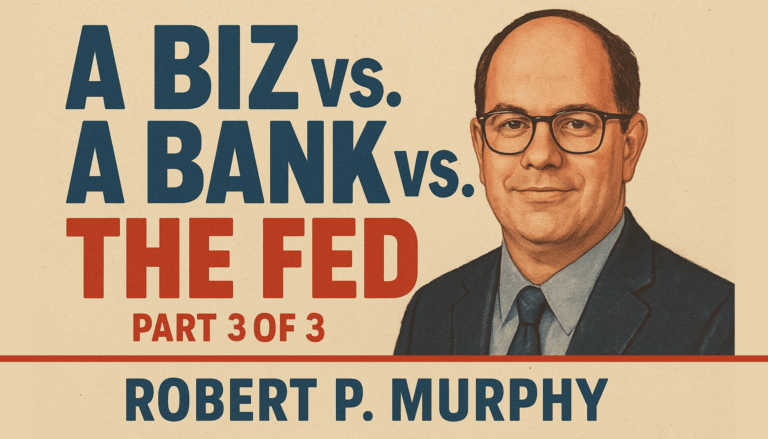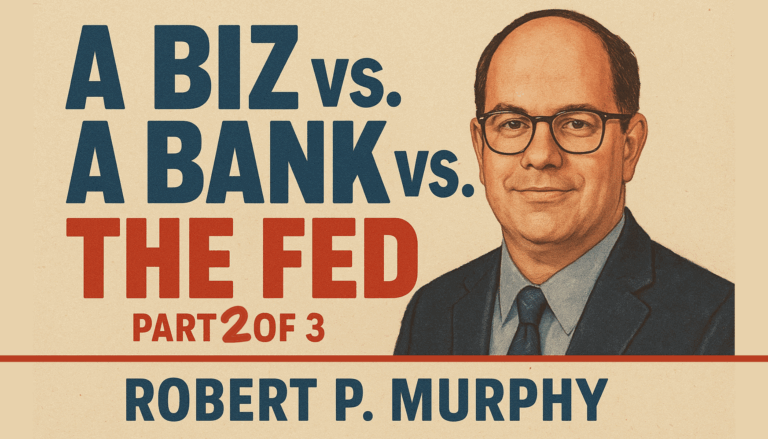Javier Milei rocked the world on Nov. 19 with his resounding runoff victoryto become Argentina’s president-elect. Milei has been called a populist and compared to Donald Trump, but he is a trained economist, holding two Masters degrees and more than 50 academic publications, and serving as an economist at various public and private sector organizations, including HSBC Argentina.
Milei is a radical libertarian, openly embracing the term “anarcho-capitalist” which refers to the complete privatization of all legitimate State functions, including judicial services and even military defense. (Although some people throw around buzzwords to signal allegiance to groups even though they haven’t done the heavy lifting, Milei has definitely read the literature on this topic…)
One of Milei’s signature proposals is a plan to dollarize Argentina and neuter its central bank. With the latest price inflation reading coming in at 143 percent, that’s a topic dear to Argentinians. In the present post, I will comment on Milei’s proposal to dollarize Argentina. However, as we’ll see, it’s very difficult to start with an existing massive State intervention in the economy and unwind it in an orderly process.
The Blueprint
Coincidentally, my colleague Nicolas Cachanosky and his co-author Emilio Ocampo several years ago had published an academic blueprint for Argentine dollarization, which Milei subsequently endorsed. (Here is a post written in English from Nicolas summarizing the plan.) In a forthcoming interview (which will drop here sometime in late November) I have Nicolas walk through the main components, but below is the high-level summary:
Bank deposits: This transition can happen quickly, as it simply involves changing the units in which electronic entries are stated. In order to prevent bank runs, the exchange rate at which this conversion occurs must be a genuine market rate, not the current “official exchange rate” which vastly overvalues the peso (relative to the current black-market rate). However, even this is tricky because the very act of converting all of the Argentine bank deposits from pesos into USD will affect the genuine market exchange rate. Notwithstanding these conceptual difficulties, in principle it is easy enough for the government to tell the banks, “You are hereby permitted to legally transform all of your customers’ peso-denominated balances with you into USD-denominated ones at the following rate…”
Paper Currency in Circulation: Transforming the actual paper currency from Argentine pesos into USD is trickier, because (unlike electronic bank deposits) the government can’t simply make an announcement that physically transforms one type of note into another. And of course, the Argentine government/central bank has no authority to print actual Federal Reserve Notes.
On this front, Nicolas and his co-author relied on the experience of Ecuador and El Salvador, which dollarized in different ways. In the case of Ecuador, the authorities (initially) set a nine-month window in which the public had to exchange their sucres for USD, at the end of which the original currency would lose its legal status and become officially worthless.
In contrast, El Salvador adopted a more voluntary approach, in which colones would perpetually remain valid, and would only gradually diminish as the public used them to pay taxes or deposit them into a bank.
Nicolas explained to me that he couldn’t say at this point which approach would make the most sense for Argentina because this was a tricky business and (among other things) the best path would depend on the reaction of the markets and the public in Argentina.
A middle approach would be a combination of these two options. I’ll quote Nicolas in his own words:
The third option is a voluntary + automatic referendum dollarization. This method is a combination of Ecuador and El Salvador methods. In this case, Argentina could start with a voluntary dollarization and transition to a compulsory one if the volume of pesos in circulation falls below a given threshold at a given date. This approach allows the government to obtain the necessary dollars to dollarize the remaining currency in circulation.
And finally, we turn to the most complicated component of their plan.
Central Bank liabilities: This is the most difficult problem, which stems from the fact that the Argentine central bank doesn’t hold standard bonds issued by the government’s treasury (the way other central banks typically do). Nicolas and his co-author came up with a multi-part procedure by which the central bank could phase out its Argentine-specific liabilities over time, in a way that wouldn’t disrupt financial markets and would give the necessary time for the government to raise USD funds over time. Because of the plan’s complexity, I refer interested readers to read Nicolas’ post directly for the details.
This is the most difficult problem, which stems from the fact that the Argentine central bank doesn’t hold standard bonds issued by the government’s treasury (the way other central banks typically do). Nicolas and his co-author came up with a multi-part procedure by which the central bank could phase out its Argentine-specific liabilities over time, in a way that wouldn’t disrupt financial markets and would give the necessary time for the government to raise USD funds over time. Because of the plan’s complexity, I refer interested readers to read Nicolas’ post directly for the details.
Relying on Market versus Arbitrary Values
As we can see, things get very messy when reformers — who are quite steeped in the benefits of market-driven outcomes rather than central planning — try to unwind State intervention in the markets. This episode reminds me of when Carlos Lara and I laid out a proposal to return the US to a gold-backed dollar in our book How Privatized Banking Really Works. I struggled with how to pick a sensible rate of dollars for an ounce of gold, and then later I saw that Ludwig von Mises had already solved the problem in an elegant way.
There are certainly bumps in the road ahead. As with more personal types of abuse, when the State imposes coercion in the financial sector and wrecks a currency, it is hard for the victims to recover and move on. I wish the people of Argentina well, but ultimately true financial security and freedom will only result from the complete separation of money and State. This is something we are working on, in our own humble way, at infineo.
NOTE: This article was released 24 hours earlier on the IBC Infinite Banking Users Group on Facebook.
Dr. Robert P. Murphy is the Chief Economist at infineo, bridging together Whole Life insurance policies and digital blockchain-based issuance.
Twitter: @infineogroup, @BobMurphyEcon
LinkedIn: infineo group, Robert Murphy
Youtube: infineo group

